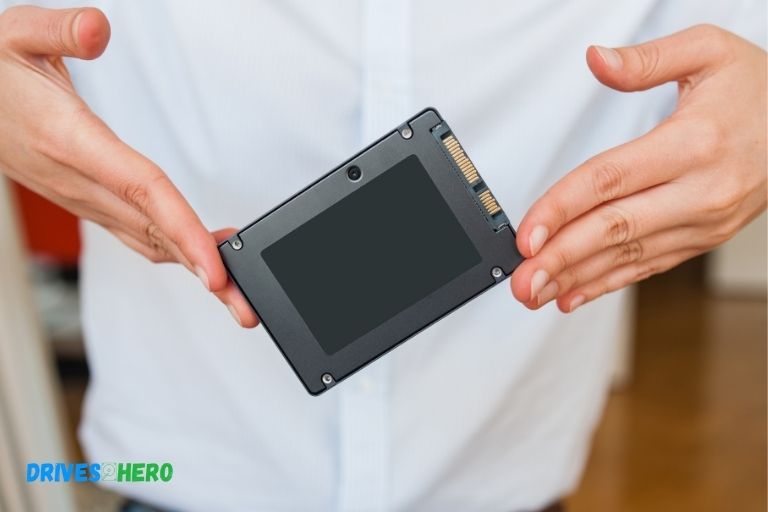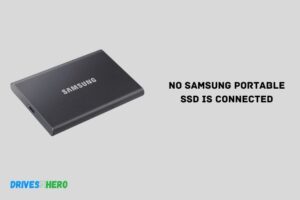How Long Do Portable SSD Last? Up To 10 Years!
A Portable SSD (Solid State Drive) can potentially last for up to 10 years if it is used moderately.
However, the lifespan of a portable SSD can vary greatly depending on how often the drive is used, the amount of data written on it, and the quality of the drive itself.
Portable SSDs are based on Flash memory technology, similar to USB flash drives but with much larger capacity and faster transfer rates.
SSDs have no moving parts, unlike traditional hard disk drives (HDDs), which makes them more durable and reliable.
The lifespan of a portable SSD is often measured in TBW (Terabytes Written), indicating the total amount of data that can be written on the drive before it starts to fail.
While the estimated lifespan for a Portable SSD can reach up to a decade, it’s important to note that the actual lifespan can be influenced by various factors.
The more data you write on the SSD and the more often you use it, the shorter its lifespan may be. Therefore, it’s advisable to regularly back up your data and replace the SSD drive when it approaches its TBW limit.

Key Takeaway
Five Facts About: How Long Do Portable Ssd Last
What Are Portable Ssds?
Portable SSDs are compact storage devices that offer fast data transfer speeds and durability. These solid-state drives are designed to last for a considerable amount of time, providing reliable performance for your data storage needs.
Portable SSDs, also known as portable solid-state drives, have become increasingly popular as a storage option in recent years.
Definition And Explanation Of Portable Ssds:
- Portable SSDs are external storage devices that utilize solid-state drive (SSD) technology.
- Unlike traditional hard disk drives (HDDs), portable SSDs have no moving parts, which means they are more durable and less prone to mechanical failures.
- Portable SSDs are designed to be easily transportable, providing users with the convenience of having their data on the go.
- These devices come in various storage capacities, ranging from a few hundred gigabytes to several terabytes.
- Portable SSDs connect to computers and other devices through interfaces such as USB or Thunderbolt, allowing for quick data transfers.
Key Features And Advantages Of Portable Ssds:
- Speed: Portable SSDs offer significantly faster read and write speeds compared to traditional HDDs. This means that accessing and transferring files is quicker, allowing for a more efficient workflow.
- Portability: As the name suggests, portable SSDs are compact and lightweight, making them ideal for individuals who need to transport their data frequently. They easily fit into pockets or bags and can be taken anywhere without hassle.
- Durability: Since portable SSDs don’t rely on mechanical components, they are more robust and resistant to shocks, drops, and vibrations. This durability makes them suitable for use in various environments and ensures that your data remains safe.
- Energy efficiency: Portable SSDs consume less power compared to HDDs. This not only extends the battery life of laptops or other devices they are connected to but also reduces the overall energy consumption.
- Silent operation: Unlike HDDs, portable SSDs generate no noise because they lack any moving parts. This makes them a quiet storage solution, suitable for environments where silence is important.
- Security: Many portable SSDs offer built-in encryption and password protection features, ensuring that your data remains secure even if the device is lost or stolen.
- Compatibility: Portable SSDs are compatible with a wide range of devices, including laptops, desktops, gaming consoles, and compatible smart TVs. They can be used with different operating systems such as Windows, macOS, and Linux.
Portable SSDs have revolutionized the world of storage devices, offering speed, portability, durability, and enhanced security in a compact design.
How Do Portable Ssds Work?
Portable SSDs are a reliable storage solution that can last for several years, providing high-speed data transfer and durability. They work by using flash memory technology to store data, making them resistant to shocks and wear.
Overview Of The Technology Behind Portable Ssds:
- Portable SSDs, or solid-state drives, are high-speed storage devices that use flash memory technology to store and retrieve data.
- Unlike traditional hard disk drives (HDDs) that rely on spinning magnetic disks, portable SSDs have no moving parts, resulting in faster access times and improved durability.
- The technology behind portable SSDs involves integrated circuits that store data using electric charges instead of magnetic fields.
- These drives utilize NAND flash memory, which retains data even without power, making them ideal for portable storage solutions.
- Portable SSDs connect to devices such as laptops, desktops, and gaming consoles via USB or Thunderbolt interfaces, providing quick and reliable data transfer.
Explanation Of The Components And Functionality Of Portable Ssds:
- Controller: The controller is the brain of a portable SSD, managing data transfer and communication between the drive and the connected device.
- NAND Flash Memory: This is the primary storage component in a portable SSD, responsible for storing data. It is available in different types, such as SLC, MLC, TLC, and QLC, each with varying capacities and performance levels.
- Interface: Portable SSDs commonly use USB or Thunderbolt interfaces to connect to devices. USB 3.0 and USB 3.1 Gen 2 interfaces provide fast data transfer speeds, while Thunderbolt 3 offers even faster performance.
- Encryption: Many portable SSDs come with built-in hardware encryption to protect sensitive data. This ensures that even if the drive falls into the wrong hands, the data remains secure.
- Durability: Portable SSDs are designed to withstand physical shocks, vibrations, and extreme temperatures. They are generally more durable than traditional HDDs and less prone to mechanical failures.
- Compact and Lightweight: One of the key advantages of portable SSDs is their compact size and lightweight design, making them highly portable and convenient for users on the go.
Comparison Of Portable Ssds With Other Storage Devices:
Portable SSDs vs. HDDs:
- Speed: Portable SSDs offer significantly faster read and write speeds compared to HDDs due to their lack of moving parts.
- Durability: Portable SSDs are more resistant to physical shocks and vibrations, making them a safer option for portable storage.
- Noise: SSDs produce no noise, while HDDs can generate sound due to the spinning disks.
- Compactness: Portable SSDs are generally smaller and lighter than HDDs, making them easier to carry around.
- Power Consumption: SSDs consume less power, leading to improved battery life for devices connected to them.
Portable SSDs vs. USB Flash Drives:
- Speed: Portable SSDs usually offer faster data transfer speeds compared to USB flash drives.
- Storage Capacity: Portable SSDs typically offer greater storage capacities, ranging from 250GB to several terabytes, while USB flash drives have smaller storage capacities.
- Durability: Portable SSDs are generally more durable than USB flash drives, making them suitable for extended use.
- Lifespan: The lifespan of portable SSDs is generally longer than that of USB flash drives due to the higher-quality components used.
- Price: Portable SSDs are usually more expensive compared to USB flash drives, reflecting their superior performance and capabilities.
Portable SSDs utilize advanced technology to store and retrieve data quickly, offering numerous advantages over other storage devices such as HDDs and USB flash drives.
With their compact size, durability, and impressive performance, portable SSDs are an excellent choice for individuals in need of high-speed and reliable portable storage solutions.
Trim Support And Garbage Collection
TRIM support and garbage collection are crucial factors that determine the lifespan of portable SSDs. These features help maintain the performance of the drive and extend its longevity by optimizing data storage and eliminating unnecessary junk files.
Explanation Of Trim Support And Its Role In Maintaining The Performance And Lifespan Of Portable Ssds
TRIM support is a crucial feature that plays a vital role in maintaining the optimal performance and extending the lifespan of portable SSDs.
By understanding how TRIM support works and its significance, you can ensure that your SSD performs at its best for a longer time.
Here’s an explanation of TRIM support and its role in portable SSDs:
TRIM support: This feature allows the operating system to inform the SSD which blocks of data are no longer in use and can be safely erased. It helps in maintaining the SSD’s performance over time by optimizing its write performance.
Erasing unused data: When you delete files from your SSD, the operating system marks the corresponding memory blocks as available for rewriting.
However, the actual deletion process doesn’t happen immediately. Without TRIM support, the SSD would gradually slow down as it tries to find empty blocks for new data.
Maintaining performance: With TRIM support, the SSD can proactively erase unused data, making room for new data to be written quickly.
This allows for consistent performance levels, preventing write performance degradation over time. It also helps in reducing the chances of encountering freezing or stuttering issues.
Extending lifespan: By regularly erasing unused data, TRIM support helps avoid unnecessary write operations on the SSD.
This reduces wear and tear on the memory cells, which ultimately extends the lifespan of the portable SSD. It can make a significant difference in the overall longevity of your device.
Compatibility: It is essential to note that TRIM support requires both the SSD and the operating system to be compatible.
While most modern SSDs come with TRIM support, it’s crucial to ensure that your operating system also supports this feature.
Importance Of Garbage Collection For Optimizing The Ssd’S Lifespan
In addition to TRIM support, garbage collection is another critical process that helps optimize the lifespan of your portable SSD.
Garbage collection goes hand in hand with TRIM support and contributes to maintaining the SSD’s performance and durability.
Here are some important points to understand the role of garbage collection in SSD lifespan optimization:
Cleaning up deleted data: Garbage collection aims to clean up deleted data that may still remain on the SSD, even with TRIM support. It identifies blocks that are no longer actively used and consolidates the valid data into contiguous memory areas.
Preventing performance degradation: If there are significant amounts of fragmented data stored across various blocks, it can lead to decreased performance over time.
Garbage collection helps in improving the SSD’s performance by minimizing data fragmentation and ensuring efficient read and write operations.
Wear leveling: Garbage collection also plays a crucial role in wear leveling, which distributes write operations evenly across the memory cells.
By doing so, it helps prevent certain memory cells from wearing out more quickly than others, thus extending the overall lifespan of the SSD.
Automated process: Garbage collection is an automatic process performed by the SSD’s firmware. It runs in the background, ensuring that the SSD is constantly optimizing its storage and maintaining its performance without any user intervention required.
By understanding the importance of garbage collection and its relationship with TRIM support, you can take proactive measures to optimize your portable SSD’s lifespan and ensure it continues to perform at its best.
Proper Usage And Handling
Portable SSDs can have varying lifespans based on usage and handling. Understanding how long they last requires proper care and maintenance, as well as attention to factors such as write endurance and overall drive health.
By following best practices, users can maximize the longevity of their portable SSDs. Portable SSDs have become increasingly popular due to their high-speed performance and portability.
Best Practices For Using And Handling Portable Ssds To Avoid Wear And Tear:
- Avoid excessive heat exposure: High temperatures can negatively impact the performance and lifespan of your portable SSD. Store it in a cool and dry place, away from direct sunlight or any heat-emitting sources.
- Utilize a protective case: Investing in a reliable protective case can safeguard your portable SSD from accidental drops, impacts, and scratches while in transit or storage. Be sure to choose a case that offers adequate shock absorption and fits your device securely.
- Disconnect properly: When disconnecting your portable SSD from a device, make sure to follow the proper ejection procedure to prevent data loss or potential damage. This can typically be done through the operating system’s built-in function for ejecting external drives.
- Regularly update firmware: Manufacturers often release firmware updates to enhance the performance and compatibility of portable SSDs. Keeping your device updated not only ensures optimal functionality but can also address any potential issues or vulnerabilities.
- Avoid excessive read/write operations: While portable SSDs are designed to endure heavy read/write operations, it’s best to avoid unnecessary or excessive data transfers. Minimizing these operations can help reduce wear and tear on the device and extend its lifespan.
- Perform regular backups: Regularly backing up your data is crucial to avoid potential data loss in case of device failure or unforeseen circumstances.
By having multiple copies of your important files, you can quickly recover them in the event of any issues with your portable SSD.
Tips For Preventing Physical Damage And Minimizing Impact On Lifespan:
- Handle with care: Treat your portable SSD with care, avoiding any unnecessary rough handling or dropping. Be mindful of how you store and carry it, ensuring it is securely placed to minimize the risk of physical damage.
- Avoid dust and moisture: Dust and moisture can cause internal damage to your portable SSD. Store it in a clean and dry environment, and avoid exposing it to liquids or areas with excessive humidity.
- Keep away from magnetic fields: Magnetic fields can interfere with the functionality of a portable SSD, potentially leading to data corruption or device malfunction. Keep your SSD away from strong magnets or magnetic devices.
- Protect against static electricity: Static electricity discharge can harm sensitive electronic components in your portable SSD. Before handling the device, ground yourself by touching a metal object, such as a doorknob, to discharge any static buildup.
By adhering to these best practices for using and handling your portable SSD, you can significantly prolong its lifespan and ensure the reliability of your data storage.
Firmware Updates
Portable SSDs can last for a long time with regular firmware updates. These updates ensure optimal performance and security, extending the lifespan of your device. Invest in firmware updates to get the most out of your portable SSD.
Importance Of Keeping The Portable Ssd’S Firmware Up To Date
Firmware updates are vital for maintaining the optimal performance and longevity of your portable SSD. By regularly updating the firmware, you can benefit from ongoing improvements and fixes provided by the manufacturer.
Below are a few reasons explaining why keeping the firmware up to date is essential:
- Enhanced performance: Firmware updates often include optimizations and bug fixes that can boost the performance of your portable SSD. These updates may resolve compatibility issues with different operating systems, improve data transfer speeds, and enhance overall system stability.
- Increased compatibility: As technology evolves, so does the need for compatibility with newer devices and software. Firmware updates ensure that your portable SSD remains compatible with the latest operating systems, devices, and software applications.
- Enhanced security: Firmware updates often include security patches that can protect your data from potential vulnerabilities. These updates address any identified security risks and minimize the chance of unauthorized access or data breaches when it comes to the safety of your files.
- Bug fixes and stability improvements: Manufacturers may discover and resolve certain software bugs or stability issues that could affect the performance of your portable SSD. Firmware updates address these bugs and improve system stability, reducing the likelihood of data loss.
- Extended lifespan: By keeping the firmware up to date, you are effectively extending the lifespan of your portable SSD. Regular updates ensure that your device operates efficiently and reliably, reducing the risk of premature wear and potential failures.
Explanation Of How Firmware Updates Can Improve Performance And Lifespan
Performance optimization: Firmware updates often include performance optimizations that can enhance the data transfer speeds and overall responsiveness of your portable SSD.
These updates may improve cache management, error correction, and wear-leveling algorithms, resulting in faster file transfers and smoother operation.
Error correction and data integrity: Firmware updates can address any existing errors or bugs that might affect data integrity on your portable SSD.
By ensuring the accuracy and consistency of your stored data, these updates help safeguard against data loss and corruption, which can have a significant impact on your work or personal files.
Efficiency improvements: Firmware updates can introduce efficiency improvements that optimize power consumption, idle times, and sleep modes.
These enhancements aim to reduce energy usage, which not only benefits the longevity of your portable SSD but also extends the battery life of your connected devices when used in conjunction with the SSD.
Wear-leveling enhancements: Wear-leveling is a technique used by SSDs to evenly distribute data usage across memory cells, preventing specific cells from wearing out prematurely.
Firmware updates may improve wear-leveling algorithms, ensuring that data is dispersed evenly and preventing excessive wear on specific areas of the SSD. This ultimately extends the lifespan of your portable SSD.
Compatibility enhancements: As technology advances, firmware updates can address compatibility issues with newer hardware and software. These updates ensure that your portable SSD remains compatible with the latest devices, operating systems, and software applications.
Staying up to date allows you to take advantage of new features and functionalities without experiencing any compatibility issues.
Remember, regularly updating the firmware of your portable SSD is crucial for accessing the latest performance enhancements, compatibility improvements, and security features.
Regular Backups And Data Integrity
The longevity of portable SSDs is a concern for many users. Regular backups are essential for data integrity and ensuring that important files are not lost.
By maintaining backups, individuals can protect their data and extend the lifespan of their portable SSDs. Portable SSDs have become increasingly popular due to their speed, durability, and compact design.
The Significance Of Regular Backups And Data Integrity
Regular backups are essential for maintaining the integrity of your data and safeguarding against potential loss.
By creating backups of your portable SSD, you can minimize the risk of losing valuable files, whether due to hardware failure, accidental deletion, or other unforeseen circumstances.
Here’s why regular backups are important:
- Data protection: Having multiple copies of your data ensures that you have a fallback option in case of any data corruption or loss. It provides an additional layer of protection and peace of mind.
- Accidental deletion: We all make mistakes, and accidentally deleting important files is not uncommon. Backing up your portable SSD regularly allows you to restore deleted files without any hassle.
- Hardware failure: Although portable SSDs are known for their durability, they are not immune to malfunctions or physical damages. By backing up your data, you can quickly transfer it to a new device in case of a hardware failure.
- Natural disasters and theft: Natural disasters like floods, fires, or theft can result in the permanent loss of your portable SSD and all the data stored on it. Regular backups mitigate the risk by ensuring your data is safely stored elsewhere.
Recommended Backup Strategies For Portable Ssds
To effectively backup and protect your data on a portable SSD, it is important to implement a reliable backup strategy.
Here are some recommended strategies to consider:
- Cloud storage: Utilize cloud storage services such as Google Drive, Dropbox, or Microsoft OneDrive to automatically sync your important files. This provides off-site storage and allows you to access your data from any device with an internet connection.
- External hard drives: Invest in an external hard drive and regularly copy your data from the portable SSD to the external drive. This provides an additional physical backup option and reduces reliance solely on cloud services.
- RAID configurations: If you require a higher level of data redundancy and protection, consider setting up a RAID (Redundant Array of Independent Disks) configuration with multiple portable SSDs. This setup ensures that data remains intact even if one drive fails.
- Scheduled backups: Establish a regular backup schedule that suits your needs. Whether it is daily, weekly, or monthly, consistency is key to ensuring your data is always protected.
Implementing these backup strategies will not only enhance the longevity of your portable SSD but also safeguard your valuable data from potential loss or damage.
FAQ About How Long Do Portable Ssd Last
How Long Do Portable Ssd Last
Portable SSDs typically last for up to five years and can withstand up to a thousand rewrites per day.
What type of storage do portable SSDs use?
Portable SSDs use flash storage, which is non-volatile and provides faster and more reliable data access and storage than traditional hard drives.
What are the benefits of using a portable SSD?
Portable SSDs offer faster read/write speeds than traditional hard drives, lower power consumption, more reliable performance, and greater portability since they are smaller and lighter than hard drives.
Are portable SSDs secure?
Most portable SSDs have built-in security features such as data encryption and password protection to ensure the data stored on them is secure.
Conclusion
Portable SSDs have become popular storage solutions due to their speed, durability, and compact size. These devices can last for a significant amount of time if used and maintained properly.
The lifespan of a portable SSD depends on various factors such as the quality of the drive, usage patterns, and storage conditions.
SSDs have a longer lifespan compared to traditional hard drives due to their lack of moving parts. With advancements in technology, we can expect portable SSDs to become even more reliable and efficient.
To maximize the lifespan of your portable SSD, make sure to regularly update the firmware, avoid excessive heat and physical damage, and securely eject the drive before unplugging it.
It is crucial to back up your data regularly to prevent any data loss or corruption. Investing in a portable SSD can be a wise choice for those in need of fast and reliable storage.






